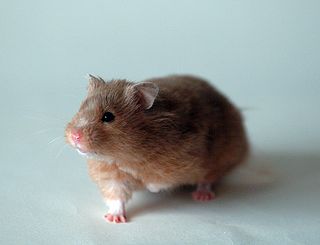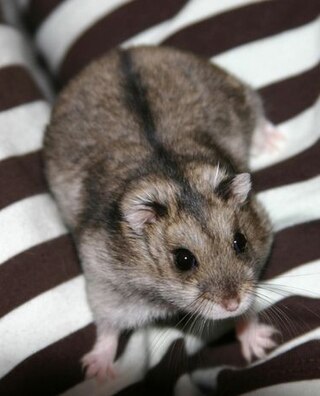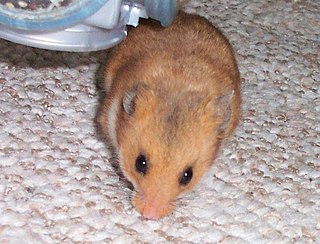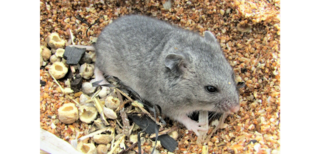
Hamsters are rodents belonging to the subfamily Cricetinae, which contains 19 species classified in seven genera. They have become established as popular small pets. The best-known species of hamster is the golden or Syrian hamster, which is the type most commonly kept as a pet. Other hamster species commonly kept as pets are the three species of dwarf hamster, Campbell's dwarf hamster, the winter white dwarf hamster and the Roborovski hamster.

The golden hamster or Syrian hamster is a rodent belonging to the hamster subfamily, Cricetinae. Their natural geographical range is in an arid region of northern Syria and southern Turkey. Their numbers have been declining in the wild due to a loss of habitat from agriculture and deliberate elimination by humans. Thus, wild golden hamsters are now considered endangered by the International Union for Conservation of Nature. However, captive breeding programs are well established, and captive-bred golden hamsters are often kept as small house pets. They are also used as scientific research animals.

The Muroidea are a large superfamily of rodents, including mice, rats, voles, hamsters, lemmings, gerbils, and many other relatives. Although the Muroidea originated in Eurasia, they occupy a vast variety of habitats on every continent except Antarctica. Some authorities have placed all members of this group into a single family, Muridae, due to difficulties in determining how the subfamilies are related to one another. Many of the families within the Muroidea superfamily have more variations between the families than between the different clades. A possible explanation for the variations in rodents is because of the location of these rodents; these changes could have been due to radiation or the overall environment they migrated to or originated in. The following taxonomy is based on recent well-supported molecular phylogenies.

Michael Rogers Oldfield Thomas was a British zoologist.

The Cricetidae are a family of rodents in the large and complex superfamily Muroidea. It includes true hamsters, voles, lemmings, muskrats, and New World rats and mice. At over 870 species, it is either the largest or second-largest family of mammals, and has members throughout the Americas, Europe and Asia.

The Nesomyidae are a family of African rodents in the large and complex superfamily Muroidea. It includes several subfamilies, all of which are native to either continental Africa or to Madagascar. Included in this family are Malagasy rodents, climbing mice, African rock mice, swamp mice, pouched rats, and the white-tailed rat.

Pouched rats are a group of African rodents in the subfamily Cricetomyinae. They are members of the family Nesomyidae, which contains other African muroids such as climbing mice, Malagasy mice, and the white-tailed rat. All nesomyids are in the superfamily Muroidea, a large and complex clade containing 1⁄4 of all mammal species. Sometimes the pouched rats are placed in the family Muridae along with all other members of the superfamily Muroidea.

Campbell's dwarf hamster is a species of hamster in the genus Phodopus. It was given its common name by Oldfield Thomas in honor of Charles William Campbell, who collected the first specimen in Mongolia on July 1, 1902. It is distinguished from the closely related Djungarian hamster as it has smaller ears and no dark fur on its crown. Campbell's dwarf hamster typically has a narrow dorsal stripe compared to the Djungarian hamster and brown or gray fur on the stomach. This hamster may be raised in captivity and kept as a small pet.

Mesocricetus is a genus of Old World hamsters, including the Syrian or golden hamster, the first hamster to be introduced as a domestic pet, and still the most popular species of hamster for that purpose.

The European hamster, also known as the Eurasian hamster, black-bellied hamster or common hamster, is the only species of hamster in the genus Cricetus. It is native to grassland and similar habitats in a large part of Eurasia, extending from Belgium to the Altai Mountains and Yenisey River in Russia. Historically, it was considered a farmland pest and had been trapped for its fur. Its population has declined drastically in recent years and is now considered critically endangered. The main threats to the species are thought to be intensive agriculture, habitat destruction, and persecution by farmers.

The Chinese striped hamster, also known as the striped dwarf hamster, is a species of hamster. It is distributed across North Asia from southern Siberia through Mongolia and northeastern China to northern North Korea. An adult Chinese striped hamster weighs 20 to 35 g, and has a body length of 72 to 116 mm with a tail of 15 to 26 mm. It is smaller and has a much shorter tail than the greater long-tailed hamster, Tscherskia triton, which inhabits much of the same range.

The lesser hamster-rat or long-tailed pouched rat is a species of rodent in the family Nesomyidae. It is found in Kenya and Tanzania. Its natural habitat is subtropical or tropical moist lowland coastal forests. It is threatened by habitat loss. Oldfield Thomas named it in honor of Sidney Langford Hinde, a British officer and recreational naturalist.
The greater hamster-rat, greater long-tailed pouched rat, or long-tailed pouched rat is a species of rodent in the family Nesomyidae. It is found in Malawi, Tanzania, and Zambia. Its natural habitats are subtropical or tropical moist lowland forest and subtropical or tropical moist montane forest. It is threatened by habitat loss.

The grey dwarf hamster, grey hamster or migratory hamster is a species of rodent in the family Cricetidae. Its range extends from Eastern Europe through the Middle East, Russia and Central Asia to Mongolia and western China. The grey dwarf hamster has grey fur and a head-body length ranging from 85 to 120 mm. The International Union for Conservation of Nature has assessed its conservation status as being of "least concern".
Sokolov's dwarf hamster is a species of rodent in the hamster and vole family Cricetidae. Previously listed as conspecific with Chinese striped hamster, it has been listed as a separate species since 1988. It has a distinctive dark stripe down its back on and otherwise grey body. It is found in China and Mongolia, and lives in burrows beneath desert shrubs.

The Romanian hamster or Dobrudja hamster is a species of rodent in the family Cricetidae. It is found in Bulgaria and Romania.

Rodents are mammals of the order Rodentia, which are characterized by a single pair of continuously growing incisors in each of the upper and lower jaws. About 40% of all mammal species are rodents. They are native to all major land masses except for Antarctica, and several oceanic islands, though they have subsequently been introduced to most of these land masses by human activity.















